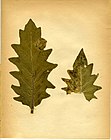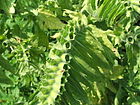Note: This is a project under development. The articles on this wiki are just being initiated and broadly incomplete. You can Help creating new pages.
Hyoscyamus niger - Pārasīkayavānī, Henbane
Pārasīkayavānī consists of the seed of Hyoscyamus niger. It is an annual or biennial herb. It is native to the Mediterranean region and temperate Asia, occurring in Western Himalayas from Kashmir to Kumaon at an altitude of 1600 to 4000 m, imported into India.
Contents
- 1 Uses
- 2 Parts Used
- 3 Chemical Composition
- 4 Common names
- 5 Properties
- 6 Habit
- 7 Identification
- 8 List of Ayurvedic medicine in which the herb is used
- 9 Where to get the saplings
- 10 Mode of Propagation
- 11 How to plant/cultivate
- 12 Commonly seen growing in areas
- 13 Photo Gallery
- 14 References
- 15 External Links
Uses
Toothache, Mania, Hysteria, Asthma, Bronchitis, Earache.
Parts Used
Chemical Composition
The chief constituent of Henbane leaves is the alkaloid Hyoscyamine, together with smaller quantities of Atropine and Hyoscine, also known as Scopolamine. The proportion of alkaloid in the British Pharmacopoeia dried drug varies from 0.045 to 0.14 per cent.[1]
Common names
| Language | Common name |
|---|---|
| Kannada | ಖುರಾಸಾನಿ ಓಮ Khuraasaani oma, ವಿಲಾಯತಿ ತುಳಸಿ Vilaayati tulasi |
| Hindi | Khurasani ajwain |
| Malayalam | NA |
| Tamil | NA |
| Telugu | NA |
| Marathi | NA |
| Gujarathi | NA |
| Punjabi | NA |
| Kashmiri | NA |
| Sanskrit | Parseek yawani |
| English | Henbane, Stinking nightshade |
Properties
Reference: Dravya - Substance, Rasa - Taste, Guna - Qualities, Veerya - Potency, Vipaka - Post-digesion effect, Karma - Pharmacological activity, Prabhava - Therepeutics.
Dravya
Rasa
Guna
Veerya
Vipaka
Karma
Prabhava
Habit
Identification
Leaf
| Kind | Shape | Feature |
|---|---|---|
| Paripinnate | Oblong | Leaf Arrangementis Alternate-spiral |
Flower
| Type | Size | Color and composition | Stamen | More information |
|---|---|---|---|---|
| Unisexual | 2-4cm long | Pink | Flowering throughout the year and In terminal and/or axillary pseudoracemes |
Fruit
| Type | Size | Mass | Appearance | Seeds | More information |
|---|---|---|---|---|---|
| Oblong pod | Thinly septate, pilose, wrinkled | Seeds upto 5 | Fruiting throughout the year |
Other features
List of Ayurvedic medicine in which the herb is used
Where to get the saplings
Mode of Propagation
How to plant/cultivate
By the walls of fields, waste ground, near buildings and in stony places from low-lying ground near the sea to lower mountain slopes. Best propagated from seeds [4]
Commonly seen growing in areas
Cultivated beds, Walls of fields, Waste ground, Stony places, Lower mountain slopes.
Photo Gallery
References
- ↑ Chemical composition
- ↑ Local names
- ↑ [ Morphology]
- ↑ Cultivation detail
External Links
- Ayurvedic Herbs known to be helpful to treat Toothache
- Ayurvedic Herbs known to be helpful to treat Mania
- Ayurvedic Herbs known to be helpful to treat Hysteria
- Ayurvedic Herbs known to be helpful to treat Asthma
- Ayurvedic Herbs known to be helpful to treat Bronchitis
- Ayurvedic Herbs known to be helpful to treat Earache
- Herbs with Leaves used in medicine
- Herbs with Seeds used in medicine
- Herbs with common name in Kannada
- Herbs with common name in Hindi
- Herbs with common name in Sanskrit
- Herbs with common name in English
- Habit - Biennial plant
- Index of Plants which can be propagated by Seeds
- Herbs that are commonly seen in the region of Cultivated beds
- Herbs that are commonly seen in the region of Walls of fields
- Herbs that are commonly seen in the region of Waste ground
- Herbs that are commonly seen in the region of Stony places
- Herbs that are commonly seen in the region of Lower mountain slopes
- Herbs
- Solanaceae




